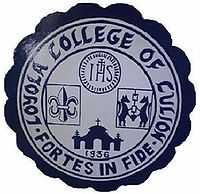Loyola College of Culion
| Loyola College of Culion | |
|---|---|
| Loyolae Collegium Culionensis (Latin) | |
|
The Jesuit College in Culion Islands, Philippines | |
Former names |
Culion Catholic School (1936-1950) St. Ignatius High School (1951-1954) St. Ignatius Academy (1955-1984) St. Ignatius College (1985-1987) |
| Motto | Fortes in Fide (Latin) |
Motto in English | Strong in Faith |
| Established | 1936 |
| Type | Private, Coeducational College |
| Affiliation | Catholic Church (Jesuit) |
| President | Fr. Adriano R. Tapiador, S.J. |
| Dean | Mary Grace F. Non, M.A. |
| Principal |
Noel U. Lagrada, M.A. (High School) |
| Students | 846 |
| Location |
Culion, Palawan, 11°50′07″N 119°59′36″E / 11.83528°N 119.99333°ECoordinates: 11°50′07″N 119°59′36″E / 11.83528°N 119.99333°E |
| Campus | Upper Libis campus |
| Colors | Blue and White |
| Website |
www |
The Loyola College of Culion is a college run by the Catholic religious order, Society of Jesus, in Barangay Libis, Culion in the province of Palawan, Philippines.
It was established as an elementary school named Culion Catholic School in 1936, and became a college in 1985 named St. Ignatius College. The school took on its present name in 1988.
History
Beginnings
The Loyola College of Culion, prior to reaching its present status, underwent various changes. Pertinent documents and records show that in June 1939, the Philippine government recognized and authorized the operation of Culion Catholic Primary School, which had been open since 1936. The school was then limited to the education of female lepers who were residents of the Hijas de Maria Dormitory run by the Sisters of St. Paul of Charters. Portions of the dormitory were utilized as the first classrooms. It was Mother Donatienne, Superior of the sisters who suggested to Fr. Hugh J. McNulty, a Jesuit priest, to establish an elementary school for their girls in 1936. The establishment of this first private educational institution in Culion, Palawan, was made possible under the auspices of the Society of Jesus (Jesuits). The school had to be closed down in 1938 due to the outbreak of World War II. In 1948, the school was turned into a co-educational grade school, called the Culion Catholic School. It, however, remained exclusive for the victims of leprosy. Only in the mid-50’s, with the enactment of the Liberalization Law for Lepers, did the doors of the school open for all.
The demand for a high school was the clamor of the time; thus, the Jesuits decided to open an institution for secondary education. In 1951, Fr. Walter Hamilton, S.J. opened the St. Ignatius High School to provide secondary education for the graduates of the Culion Catholic School. After 4 years, Fr. Pedro Dimaano, S.J. decided to merge the two schools thus giving birth to the St. Ignatius Academy.
The desire of the Jesuits for the educational development and spiritual upliftment of the people of Culion, including the inhabitants of the neighboring municipalities, gave birth to the first and only private college in Culion. In 1985, under the guidance of school director Fr. John Chambers, S.J.,the school decided to start offering a sole course in Bachelor of Arts, Major in Literature. Thus the name of the school was changed from St. Ignatius Academy to St. Ignatius College. The college was again renamed as Loyola College of Culion in 1988.
With the support of the Sisters of St. Paul de Chartres and the local government, the Society of Jesus Philippine Province has successfully established a total and complete educational institution in Culion, to combat illiteracy and ignorance of the constituents thereat.
Current Situation
Although leprosy in Culion has been totally eradicated, the stigma, however, still remains. The small municipality is poor and is mostly dependent on fishing and farming. Loyola College of Culion, therefore, continues to help finance the education of many of the poor inhabitants of Culion and its surrounding islands and municipalities. For the school year 2008-2009, Loyola College of Culion had a total of 554 students (262 in Grade School, 218 in High School, and 74 in College). But the survival of the school mostly depends on the subsidy from the Society of Jesus - Philippine Province and ANESVAD. The education of each students is, in fact, 70% subsidized (60% by ANESVAD, and 10% by the Jesuits). Furthermore, about 40% of the students receive scholarships from various agencies over and above the huge subsidy that is already provided by ANESVAD and the Society of Jesus.
However, the contract with ANESVAD, a funding institution from Spain, is ending in May 2009. ANESVAD has already announced the cessation of the contract and its non-renewal.
The poor families of the students of Loyola College of Culion clearly cannot afford to shoulder the full amount of the cost of education of their children. The Society of Jesus also cannot afford to take on the 60% subsidy that ANESVAD has been giving. With the eventual withdrawal of ANESVAD in 2009, therefore, Loyola College of Culion will have to look for alternative sources of funding to sustain its operation, otherwise, the school will have to close down.
Education of the people in Culion remains a very important and a much-needed program in uplifting poverty in this place. Furthermore, since Culion together with its neighboring islands in Calamianes have wonderful natural resources such as beaches and diving sites, the local government has slowly been developing the area for tourism. Education of the people of Culion and its neighboring islands (with indigenous inhabitants) will be helpful in protecting the people from abuse of their dignity and their natural heritage as a people.
Academic programs
- Bachelor of Arts, Major in Literature
- Bachelor of Science, Major in Entrepreneurial Tourism
External links
| ||||||||||||||||

